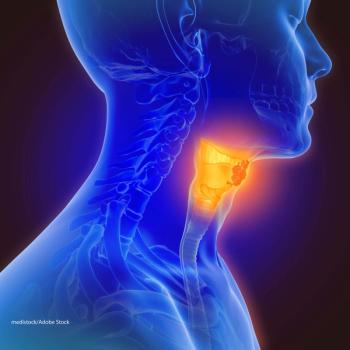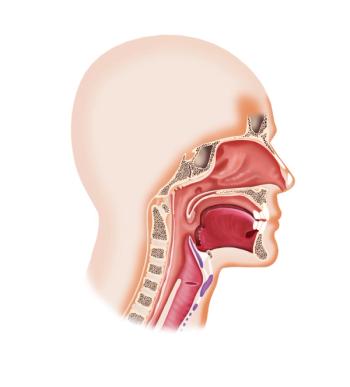
- ONCOLOGY Vol 14 No 10
- Volume 14
- Issue 10
UFT/Leucovorin in Advanced Squamous Cell Carcinoma of the Head and Neck Administered With Radiotherapy
This is an open-label, nonrandomized phase I study to determine the maximum tolerated dose and dose-limiting toxicity of UFT plus leucovorin when given concomitantly with hyperfractionated radiotherapy in patients with head and neck cancer. The study period is determined by the course of radiotherapy, which is given as 1.7 Gy per fraction twice daily for 5 days (Monday to Friday) in 2 consecutive weeks, followed by 1 week of rest, and subsequently another 2 weeks of radiotherapy (Monday to Friday plus Monday to Thursday).
ABSTRACT: This is an open-label, nonrandomized phase I study to determine the maximum tolerated dose and dose-limiting toxicity of UFT plus leucovorin when given concomitantly with hyperfractionated radiotherapy in patients with head and neck cancer. The study period is determined by the course of radiotherapy, which is given as 1.7 Gy per fraction twice daily for 5 days (Monday to Friday) in 2 consecutive weeks, followed by 1 week of rest, and subsequently another 2 weeks of radiotherapy (Monday to Friday plus Monday to Thursday). Total duration of therapy will be 5 weeks. [ONCOLOGY 14(Suppl 9):79-81, 2000]
Radiotherapy and UFT (uracil and tegafur) plus oral leucovorin (a combination being developed under the trade name Orzel) are administered simultaneously for the treatment of advanced squamous cell carcinoma of the head and neck. The starting dose level is UFT at 150 mg/m²/d plus leucovorin at 90 mg/d in three divided doses (Table 1 and Table 2).
Toxicity is determined for each cohort of three or more patients. If no dose-limiting toxicity is observed, the UFT dose is escalated in the next cohort of three patients (each dose level increases by 50 mg/m²/day). The dose of oral leucovorin remains fixed at 90 mg/day. If a dose limiting toxicity is observed in one of three patients, the cohort is expanded to include six patients, and if dose-limiting toxicity is observed in only one of six patients, dose escalation continues.
The maximum tolerated dose is defined as the dose level at which two or more of six patients experience a dose-limiting toxicity. A dose for phase II testing will then be recommended. Additional patients, to a maximum of 12, are then enrolled at one dose level below the maximum tolerated dose.
Eligibility is defined according to the following inclusion criteria: (1) histologically confirmed stage III or IV squamous cell carcinoma of the head and neck region; (2) evaluable or measurable disease; (3) age ³ 18 years; (4) World Health Organization performance status £ 2; (5) life expectancy of ³ 3 months, allowing for adequate follow-up of toxicity evaluation; (6) patients written consent according to local Ethics Committee requirements; (7) no previous treatment with chemotherapy, immunotherapy, or radiotherapy (prior experimental therapy is not allowed); (8) absolute neutrophil count (ANC) ³ 2.0 ´ 109/L, platelet count ³ 100 ´ 109/L; (9) liver function test values should be bilirubin £ 1.25 ´ upper limit of normal, aspartate aminotransferase £ 2 ´ upper limit of normal, alanine aminotransferase £ 2 ´ upper limit of normal, alkaline phosphatase £ 2 ´ upper limit of normal; (10) serum creatinine £ 1.25 ´ upper limit of normal; (11) all women of childbearing potential must have a negative serum or urine pregnancy test (minimum sensitivity 25 IU/L of b-HCG [human chorionic gonadotropin]) within 72 hours prior to the start of study medication; (12) patients must be able to take oral medication; and (13) no clinical signs of brain involvement or leptomeningeal disease.
Patients are excluded if any one of the following is met: (1) distant metastatic disease; (2) any other concomitant malignancy, with the exception of adequately treated basal cell skin cancer or in situ cervical cancer; (3) inability to follow the treatment and evaluation schedule; (4) any other condition or therapy that, in the investigators opinion, may pose a risk to the patient or interfere with the study objectives; (5) pregnant or nursing women or women of childbearing potential not using adequate methods of birth control; (6) patients with active infections or any other serious underlying medical condition that would impair the ability of the patient to receive protocol treatment; (7) one or both eyes are to be included in the irradiated area; (8) the planned external irradiation doses exceed 68 Gy to the tumor.
Dose-limiting toxicity is defined as one of the following: (1) continuous mucositis grade 4 during weeks 4 and 5 resulting in interruption of the radiotherapy treatment; (2) grade ³ 3 nausea, vomiting, or diarrhea despite medical intervention; (3) grade 4 hematologic toxicity or neutropenic fever; (4) compliance below 75% of planned chemotherapy dose during the treatment period due to toxicity; (5) prolongation of the rest period resulting in a total treatment period > 5 weeks; (6) grade ³ 3 neurologic toxicity; (7) grade ³ 3 renal, hepatic, cardiac, or pulmonary toxicity (alopecia will not be considered a DLT).
Patient characteristics are outlined in Table 3. To date, complete responses have been seen in five patients (Table 4). Toxicity is detailed in Table 5.
Concomitant UFT plus leucovorin and hyperfractionated radiotherapy at low doses of UFT is feasible and well tolerated. Nondose-limiting grade 3/4 mucositis was seen in all patients at the first two dose levels tested. Other nonhematologic toxicity was mild. No hematologic toxicity has been observed yet. The combinationof UFT/leucovorin with hyperfractionated radiotherapy shows promising activity.
Articles in this issue
about 25 years ago
New Awards Spotlight Courage of Cancer Survivorsabout 25 years ago
Children’s Art Project at M. D. Anderson Cancer Centerabout 25 years ago
Settling on an Increased NCI Budgetabout 25 years ago
Computer Billing Standardabout 25 years ago
Ligand Receives FDA Marketing Clearance for Bexarotene Gelabout 25 years ago
Mayo Clinic Study Shows Patients Uncertain About Cancer Risk Termsabout 25 years ago
Multidisciplinary Management of Pediatric Soft-Tissue SarcomaNewsletter
Stay up to date on recent advances in the multidisciplinary approach to cancer.





















































































